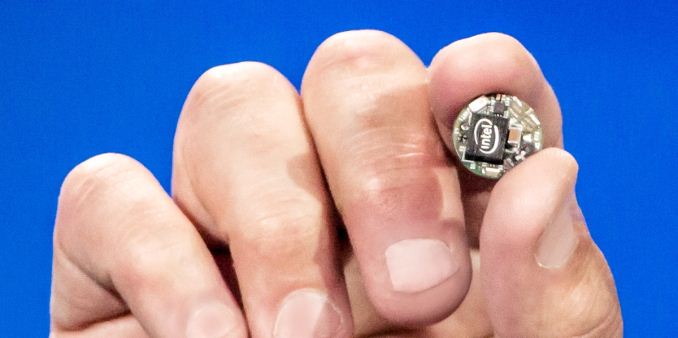Intel Announces Curie: Tiny Module for Wearables
by Stephen Barrett on January 7, 2015 11:31 AM EST
Yesterday, Intel announced a new module targeted to wearable technology: Intel Curie. This module continues Intel's push into IoT and wearable technology started with the Intel Edison. While we thought Edison was small, at just above the size of a US postage stamp, Curie goes even further. Intel has not revealed exact dimensions, but the overall package appears to be the size of a US dime, or small button. The circular PCB shape is also fairly unique and novel. Curie is so small it could theoretically be integrated into rings.
Despite its size, Curie packs in a reasonable amount of functionality. Curie is headlined by a new SoC Intel claims is their first purpose-built for wearables: the Quark SE. Curie was only just announced so we do not have complete specifications yet but I have compiled what is available.
| Intel Curie | Intel Edison Development Platform | |
| CPU | Quark SE @ ? MHz | Dual-Core Silvermont Atom @ 500MHz + Quark @ 100MHz |
| RAM | 80kB SRAM | 1GB LPDDR3 (2x32bit) |
| WiFi / BT | "BT Low Energy" | 2.4/5GHz 802.11a/b/g/n, BT 4.0 |
| Storage | 384kB flash | 4GB eMMC |
| I/O | Battery charging PMIC | SD + UART + SPI + GPIO + USB 2.0 OTG |
| OS | Open source Real-Time OS | Yocto Linux v1.6 (CPU) Open source Real-Time OS (MCU) |
| Dimensions | Approx. US dime (~18mm diameter) |
35.5 x 25 x 3.9 mm |
| Sensors | Integrated DSP sensor hub with pattern matching 6-axis combo sensor (accelerometer and gyroscope) | - |
Intel did not specify if the Bluetooth antenna was built into the PCB or needs to be added on. As Curie integrates sensors and a battery charging PMIC directly whereas Edison provides interfaces to connect to those same features, it is clear Intel designed Curie to be stand alone. Therefore, accounting for the other hardware that needs to be built around Edison, the size difference grows.
Intel's Curie does not include an applications processor and instead relies entirely on the MCU. This may seem limiting compared to powerful Galaxy Gear or Android Wear devices, but there are many devices such as Fitbit and even the Microsoft Band that also exclude an applications processor. This should enable Curie to be exceptional for battery life, however Intel provided no power consumption figures.
Curie will ship in 2H 2015 and be bundled with Intel IQ Software Kits. Intel IQ is a set of algorithms, device software, smartphone apps, and cloud integration (management, analytics, user and company portals) and breaks down into two components: Body IQ and Social IQ with corresponding biometric and connectivity focuses.










23 Comments
View All Comments
Stephen Barrett - Wednesday, January 7, 2015 - link
It is x86 though. Its an x86 MCU. It uses the Pentium ISA. See Anand's piece on Quark: http://www.anandtech.com/show/7387/intel-announces...Stephen Barrett - Wednesday, January 7, 2015 - link
and MCU and CPU are not mutually exclusive. An MCU is an SoC with a CPU inside it. But that CPU doesn't have an MMU so its not an AP.Acronym soup :)
ddriver - Wednesday, January 7, 2015 - link
It is not acronym but abbreviation. NASA is an acronym, as it is pronounced nasa, CIA is an abbreviation since it is pronounced si ay ey, not sia ;)soydeedo - Wednesday, January 7, 2015 - link
Uh...no.ddriver - Wednesday, January 7, 2015 - link
Thou shall try to make use of the schooling ;) It is never too late to finally learn what acronym actually means.easp - Thursday, January 8, 2015 - link
ddriver, I think your schooling led you astray. Both NASA and CIA are acronyms. They are both also, arguably, abbreviations, in that an acronym is a way that phrases are abbreviated into words.ddriver - Thursday, January 8, 2015 - link
http://en.wikipedia.org/wiki/Acronymkaix2 - Wednesday, January 7, 2015 - link
you can't be serious..woggs - Wednesday, January 7, 2015 - link
yes he is.https://www.youtube.com/watch?v=y_HscBWJhNQ
DanNeely - Wednesday, January 7, 2015 - link
Quark is an x86 product; other versions have been available since late 2013. It uses the Pentium 1 instruction set; but the block diagram Intel has published indicates that it's built around a modified 486 core not the P54 used in early Pentiums. The specs for this model indicate that it's a microcontroller; not something you could run a conventional OS on.http://en.wikipedia.org/wiki/Intel_Quark
http://arstechnica.com/information-technology/2013...